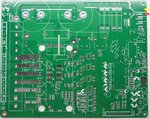RedAlert
Member level 1
- Joined
- Oct 13, 2001
- Messages
- 38
- Helped
- 0
- Reputation
- 0
- Reaction score
- 0
- Trophy points
- 1,286
- Location
- Somewhere in Israel
- Activity points
- 176
Hi,
I do know what is SMOBC which is a polymer over the copper traces to protect them, prevent bridges in wave solder process and provide better look to the PCB board.
What I do not understand is that I see this solder mask layer applied to the rest of the PCB. if it is applied to the rest of the PCB then name SMOBC is deceiving a bit because the name implies it is for the copper traces only (Solder Mask over Bare Copper)
I've supplied a PCB image with two arrows (Red and Yellow) in the upper right. It is clearly seen that solder mask is applied to the trace as indicates the Red arrow, but near the Yellow arrow - is this a solder mask or a native color of the PCB material? also is it possible to spot the PCB Material from the picture (FR4?)?
I think that SMOBC used in the past only to the PCB traces but with time it is applied to the whole PCB. what do you think?
Thanks in advance.
I do know what is SMOBC which is a polymer over the copper traces to protect them, prevent bridges in wave solder process and provide better look to the PCB board.
What I do not understand is that I see this solder mask layer applied to the rest of the PCB. if it is applied to the rest of the PCB then name SMOBC is deceiving a bit because the name implies it is for the copper traces only (Solder Mask over Bare Copper)
I've supplied a PCB image with two arrows (Red and Yellow) in the upper right. It is clearly seen that solder mask is applied to the trace as indicates the Red arrow, but near the Yellow arrow - is this a solder mask or a native color of the PCB material? also is it possible to spot the PCB Material from the picture (FR4?)?
I think that SMOBC used in the past only to the PCB traces but with time it is applied to the whole PCB. what do you think?
Thanks in advance.
